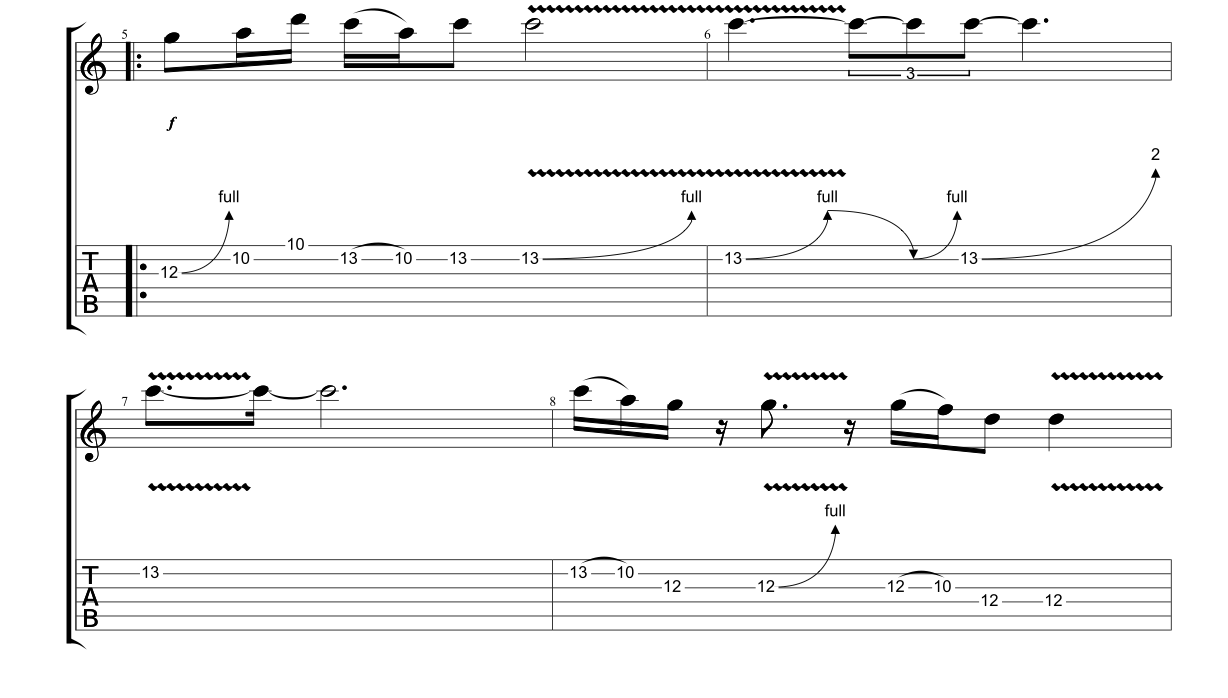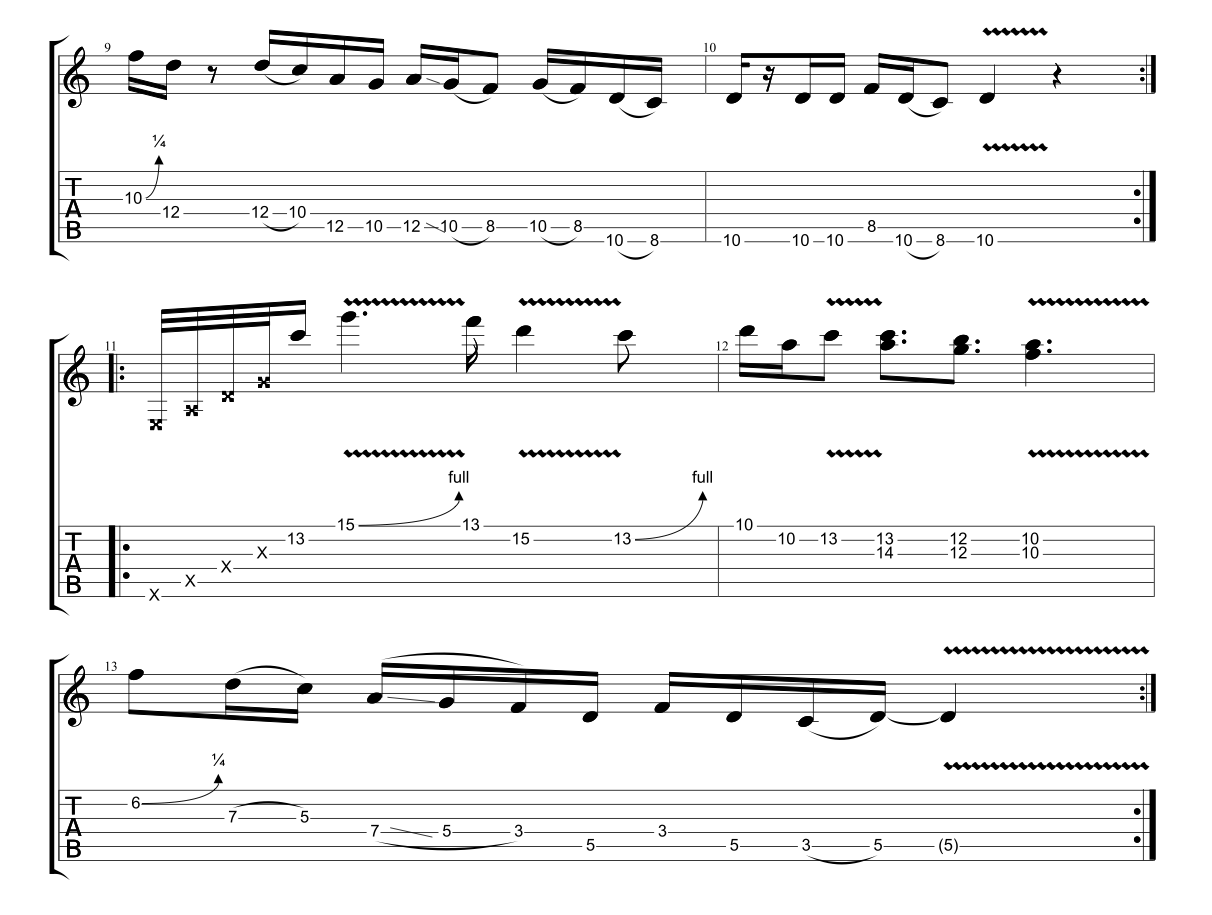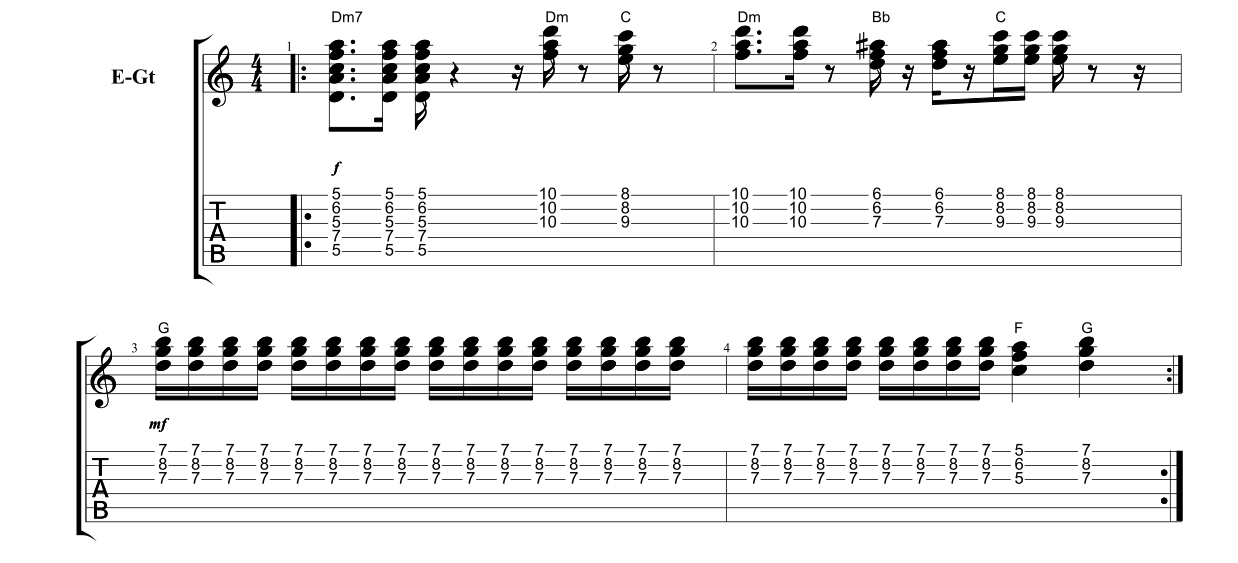Play Guitar Like Dave Gilmour
In this lesson, we are checking out three guitar licks in the style of Pink Floyd’s maestro, Dave Gilmour. His style is synonymous with the finest blues guitar licks around, combining silky-smooth lead guitar and a classic Fender Stratocaster sound.
Dave Gilmour Guitar Example 1 – Chord
Gilmour’s funk guitar rhythm technique is often overlooked. Triads, or ‘three note chords’ form the basis of this example. The combination of ‘E shape’, ‘E minor shape’ and ‘D shape’ triads used canquite quickly spice up a simple rhythmic chord pattern.
Dave Gilmour Guitar Example 2 – Technique
Here, our technique focus is the two-tone bend. Normally as guitarists we will either bend a tone (two frets), or a semitone (one fret). Gilmour’s signature sound involves bending four frets (or two tones). I recommend that you pick the note you are aiming to bend to. This will train your ear to bend in pitch, something that is vital in this style of blues playing. If you are really struggling try lowering your gauge of strings too.

Dave Gilmour Guitar Example 3 – Guitar Lick
I added another technique into this lesson today ‘the rake’. By muting the strings with your picking hand and strumming through the strings gently, aiming for one specific note, you can create a really cool new sound. Today we are raking through and hitting a melodic bend at the 15th fret on the high E string. Try adding this technique into the start of your blues licks. At the end of the video, I slowed just the rake down for you to copy.

Recommended listening
For classic Dave Gilmour style guitar licks, I recommend buying the album “The Wall.” My favourite track on that album being “Another Brick in the Wall Part 2.”
Subscribe on Youtube
Make sure you log on and subscribe to our new YouTube Channel, dedicated to bringing you the finest free guitar lessons.
Guitar Lesson Video Transcription
Hi YouTube, Simon here once again for Fundamental Changes. Today I thought it’d be appropriate to have a look at Dave Gilmour, after the new Pink Floyd release. We’re going to look at 3 techniques and styles of his. Let’s get to that just after this.
Example 1 revolves around the chord, while we’ve been looking at in the last 3 videos. So, today is not so much 1 single chord, I’m talking about the concept of triads, 3 note chords, not the Asian Mafia.
Today we’ve got a D minor 7. Now this is sort of like we looked at with the Santana chord, but in the 5th position shape, is like an A minor 7. You’ve got a barred 5th fret, A minor chord on the top, drop off a little finger. You’re going to strum that a few times, you’ll see that in a minute.
Then we’ve got this little triad pattern that’s really nice. We’ve got a D minor, top 3 strings, 10 frets, and then we go to a C, 9-8-8, then back to the D minor, then we get a little run up with these major shapes 7-6-6, 9-8-8, which is back from the B flat and the C once again.
These chords are coming from the D minor in the E shape, the D minor in the E minor shape, the C in the E shape, and the B flat in the E shape too. The top 3 strings of those shapes there. Then we’ve got a little D shape the G, and an F, which is quite a kind of classic idea for this too.
Often people just think of just soloing stuff with Dave Gilmour, but often, he’s quite a funky triadic work as well. Sounds wicked, and I’m a big fan, and it revolves around D minor. Check it out, move these triads around to different keys, and I hope you enjoy this lick.
[guitar playing]
Example 2 today introduces a technique as it follows in this series. The technique today is a super fun one,it’s the 2-tone bend. Normally, when we’re bending, we’re bending a tone, or 2 frets on the guitar. You can bend other amounts. Of course you can, you can bend any distance you like. Today we’re up around the D minor pentatonic, and we’re going to be bending the 13th fret of the 2nd string, the note of C, and we’re going to be bending that 2-tones, or the equivalent of 4 frets there.
When you bend that up, you’re going to start off with a tone, and then you’re going to keep on pushing up until you get this Dave Gilmour style bend. Now, if you’re having trouble with getting that, there’s a couple of things you can do. Make sure you pick the note of the pitch you want to get to before you get there.
If you’re really having trouble, you can lighten strings, I’m currently using 9s, I think, on the strap here today, because I like to make life a little bit easier for myself when I’m playing and teaching all day.
So, the 2-tone bend, and then we’ve got a classic D minor pentatonic example in a couple of additions there. The technique I want you to add into your playing today is the 2-tone bend. Enjoy it.
[guitar playing]
The lick in the style of, example 3 here today, I’ve actually incorporated another technique just for all you technique-y type people. Today we’re going to look at the rake. This is quite a hard thing for me to teach, but the simple principle is that you’re going to be muting the strings, pushing through with your plectrum, and then playing 1 specific note.
In this case, we’re going to be bending the 15th fret of the top string. You’re going to put the fleshy part of your hand on, you’re going to be push through all those, and lift it off and aim to bend up just that 1 string.
You can start to apply this rake anywhere you like, and it gives a very classic Dave Gilmour sound. The rest of this lick uses some little D minor double stops, and then goes into position of 4, and a tiny little position 3 up around the D minor as well. The rest of that would seem fairly familiar.
So, 2 things from today’s lesson that you can really add into your techniques are the 2-tone bend, we looked at in the last example, and the rake itself. Watch how I approach these, and I’ll slow it down so you can see that. I really hope you’ve enjoyed these.
Once again, check out the article. I’ll see you soon.
[guitar playing]
Hi everyone, thanks for watching these tips and tricks on Dave Gilmour. I really hope you enjoyed it. Make sure you go and check out Fundamental Changes website, and also check out my YouTube channel, SDPguitar as well, for more free bite-sized videos, with tabs too. I’ll see you next time.
“The artists you work with, and the quality of your work speaks for itself.”
Tommy Emmanuel
© Copyright Fundamental Changes Ltd 2025
No.6 The Pound, Ampney Crucis, England, GL7 5SA

